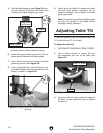
-28-
G8144Z/G8145Z/G8146Z
Vertical Metal Cutting Bandsaw
Cutting Overview
ELECTROCUTION HAZARD
This bandsaw is not designed to be used
with water soluble cutting fluid or coolant.
If needed, use a small amount of oil-based
lubricant.
Always disconnect power
to the machine when
changing blades. Failure
to do this may result in
serious personal injury.
All saw blades are dan-
gerous and may cause
personal injury. To reduce
the risk of being injured,
wear leather gloves when
handling saw blades.
Blade Changes
To replace the blade:
1. DISCONNECT BANDSAW FROM POWER!
2. Open the upper and lower wheel doors.
3. Release tension on the blade by rotating the
tensioning handwheel.
4. Put on heavy gloves, then slide the blade
off the upper and lower wheels, around the
blade post, and through the table slit.
5. Install a new blade in reverse order.
blade changes
The vertical metal cutting bandsaw has a flexible
continuous blade that cuts in one direction. The
type of bandsaw blade and the speed of the blade
to be used depends on the workpiece material
and the type of cut required.
This type of bandsaw can be used for straight cuts,
angular cuts, and curved or contour cuts. Straight
cuts are made using workpiece fixtures and with
a light, even pressure against the blade. Angular
cuts are made with the table and workpiece tilted
at an angle other than "0".
When an internal contour cut is to be made, a
hole must be drilled in the workpiece. The blade
is then cut, fed through the hole in the workpiece,
welded together again using the welding station,
and re-installed on the bandsaw to make the cut.
The welding station can also be used to fabricate
new blades and repair broken blades.
The blade is supported by upper and lower tung
-
sten steel blade guides that keep the blade from
wandering during the cut.
The efficiency of the cutting operation can be eas
-
ily checked by examining the form and color of the
metal chips.
Workpieces that cannot be supported or
stabilized without a vise or jig should not
be cut on a vertical metal-cutting bandsaw,
because they can unexpectedly move while
cutting and draw the operator's hands into
the blade causing serious personal inju-
ry. Examples are chains, cables, round or
oblong-shaped workpieces, workpieces
with internal or built-in moving or rotations
parts, etc.


















